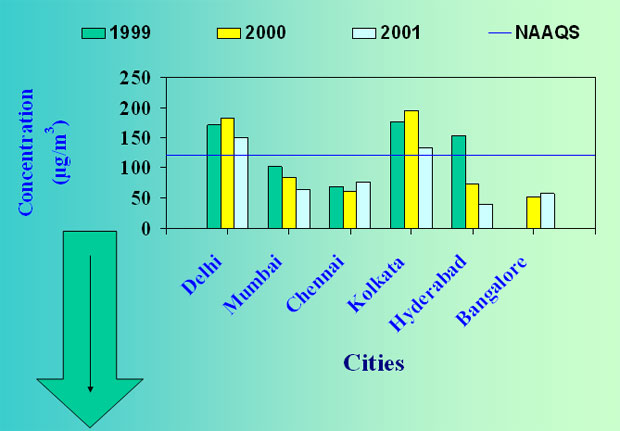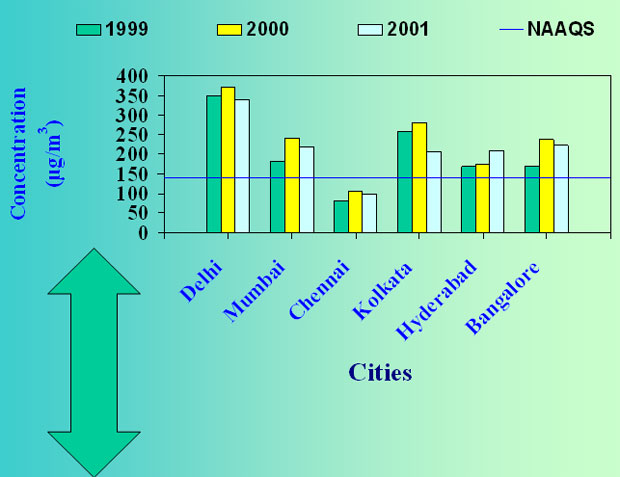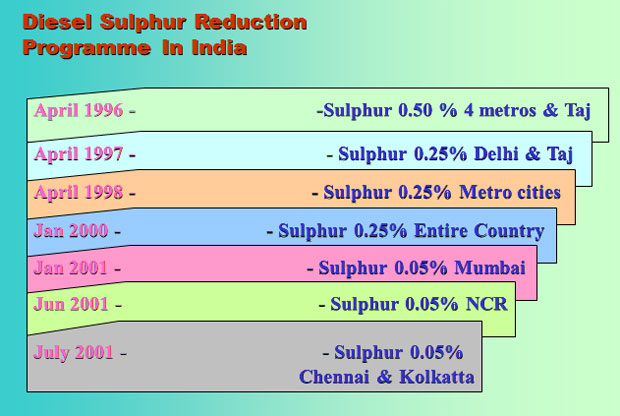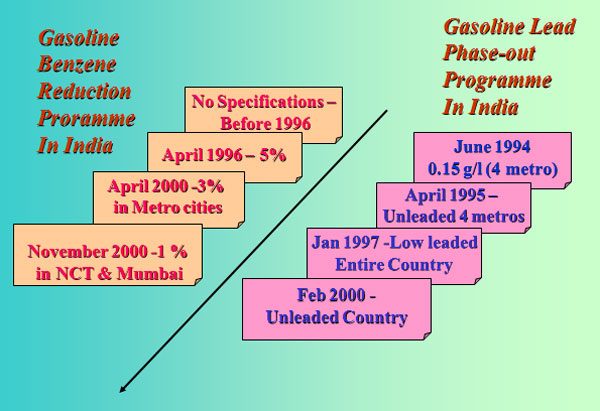Advantage Mumbai
The cities natural geographic and topographic location is such that the peninsular shape broadening from south to north and its close vicinity to sea facilitates easy flushing of the pollutants to the sea as a result of Land – Sea – Land breeze shifts, rules out any dangerous smog formation over the city. Its moderate temperatures through out the year ensure reasonably good atmospheric conditions.RSPM ( INDUSTRIAL AREAS)

Figure : 5 Decreasing values of respireable suspended particulate matter in industrial areas over years in major cities of India.
The Good Reasons are
- Vehicular emissions norm were enforced from 1990 in India with first set. In 1996 the second set of more stringent norms introduced. The Euro I equivalent norms were enforced all over the country with Euro II equivalent emission norms for four metro cities.
SPM ( RESIDENTIAL AREAS)

Figure : 6 almost constant values of suspended particulate matter over years in major cities in India. - From April 1996 government of India under took reduction in Sulphur content of fuel in four metro cities and for vehicles and refineries around Taj Mahel. Extending the programme to the entire country in 2000 and further more till July2004.

Figure : 7 Gradual progressions of stringent vehicular emission norms.and further more till July2004. - Reduction in Lead content programme started in June 1994 and continued till February 2000, from which date Unleaded vehicular fuel was available all over India.

Figure : 8 Reduction of Sulphur in fuelll over India. - Reduction in Benzene was not specified until 1996. By April 1996 the benzene content in fuel was lowered to 5% to 3% in April 2000 to 1% by November 2000 in Mumbai.

Figure : 9 Reduction in Lead and Benzene content of Gasoline
Way ahead
We need more and more insight into the whole issue of air pollution as better knowledge will provide intelligent use of resources for the control of air pollution. The international effort has to be integrated within the state and national level initiative. The examples of various cities worldwide need assessment and understanding before we adopt them for the benefit of air pollution reduction. Barriers to implementation need careful assessment with a view to gauge the aspirations of the population with health protection as the first motive.Table :1 Some major Air Pollutants, their sources and related health hazards
| Pollutant | Source | Effects on human health |
| Carbon Monoxide |
Incomplete fuel combustion (e.g. two-stroke engine) |
Fatal in large doses; aggravates heart disorders; effects central nervous system; impairs oxygen carrying capacity of blood |
| Sulphur Dioxide | Burning of Sulphur containing fuel like coal in power plants and oil by vehicles |
Affects the functions of lungs |
| Suspended Particulate matter |
Smoke from domestic, industrial and vehicular sources |
Small particles are poisonous. They are carriers of carcinogenic tracer elements |
| Nitrogen oxides | Fuel combustion in motor vehicles, power stations and furnaces |
Affects respiratory system, irritation of respiratory tract |
| Volatile hydrocarbons | Partial combustion of carbonaceous fuels (two stroke engines, industrial processes, disposal of solid wastes)
|
Drowsiness, eye irritation, coughing |
| Oxidants and ozone | Emissions from motor vehicles, photochemical reactions of nitrogen oxides and reactive hydrocarbons |
Causes increased sensitivity to infections, lung diseases, irritation in eyes, nose and throat, risk asthmatics, children and those involved in heavy exercises. |
| Lead | Emissions from motor vehicles |
Nervous system slow down and brain development is retarded. |
| Aldehydes | Chemicals |
Irritation of eyes, nose, throat, sneezing, coughing, nausea, breathing difficulties, carcinogenic in animals. |
Source : compendium of Environmental Statistics, 1998 and 1999
---o0o---
